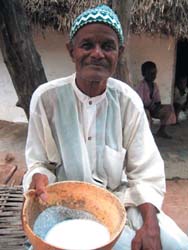 |
 |
|
 |
 |
 |
USAID Information:
External Links:
|
|
 |
 |
|
You are here » Home » Telling Our Story
|
Senegalese villagers are taking new responsibility for their natural resources |
| Forest Management Restores a Cultural Symbol |
|
For the Pulaar ethnic group of Senegal, “kosam” – curdled milk – is a dietary staple and a cherished symbol of health, purity, and prosperity. Eaten daily with millet and used in traditional rituals, kosam was once a part of Pulaar society year-round, particularly in Saré Bidji and Ndorna which is located in the southern region of Kolda, Senegal near some of the country’s remaining forest lands.
In early 2001, however, no one in the area could remember the last time their cows had produced milk beyond the six-month rainy season. “The forest here used to be richer, there was more pasture, and the grasses grew back faster after forest fires,” said El Hadji Woora Baldé, a local village chief. “Each cow produced around four liters of milk per milking [but] the grasses they used to eat have disappeared.”
|

|
“This year our rural collectivity has really seen the impact of USAID’s local project. We understand the role that our whole community plays in protecting the forest.”
- Bomelle Baldé, mother of nine
Forest degradation began as the populations of surrounding villages grew. Forest fires went unchecked, and preventive measures were limited to the perimeters of villages. Moreover, outsiders have come to exploit the forest for fuel wood and charcoal. This combination of factors has resulted in lower rainfall, soil depletion and erosion, the disappearance of healthy pasture, and diminished supply of edible wild fruits. Villagers recognized these problems but felt powerless. Natural resource management had long been the responsibility of the national government and its Forestry Service.
|
| Photo: DGL Felo
|
El Hadji Woora Baldé, chief of Saré Diaobévillage in the collectivity of Ndorna, with local kosam.
|
| |
With support from USAID, representatives from more than 200 villages in the Saré Bidji and Ndorna collectivities came together to discuss their most pressing needs - forest management emerged as their number one priority. Although the villages each had a forest fire committee dating back to before governmental decentralization, these were long defunct. USAID assisted in rejuvenating these committees, and helped to organize workshops to inform local citizens about their environmental responsibilities under decentralization. USAID helped them reestablish active forest committees and clearly define the tasks of the committee members -- which would now extend beyond putting out fires, to include monitoring forest use and reporting to the Forestry Service.
USAID provided grants in the form of bicycles, motorcycles, fire gear, and committee uniforms and badges to enable the committees to get to work. Officials, village chiefs, and representatives of women’s and youth groups worked with USAID to build their administrative capacity. Workshops were used to teach officials how to guide the budget process, and show citizens the impact that their tax contributions could have on community goals. USAID assisted the rural councils and committees in setting up a system for reporting and tracking, as well as an inter-village communication strategy to ensure reliable coordination of preventive and emergency measures.
For the first time in years, the villagers of SaréBidji enjoyed kosam straight through the dry season. USAID’s efforts to strengthen natural resource management through better governance have resulted in a notable shift in both the value that citizens and elected officials place on their environment, and the level of responsibility that they take to protect their natural resources.
|
|
Print-friendly version of this page (244kb - PDF)
Back to Top ^
|


